Scientific names:
Prunus avium ‘White Gold’
Prunus avium ‘Black Gold’
Prunus cerasus ‘Surefire’
Family: Rosaceae (Rose)
Article by Susan Bruneni
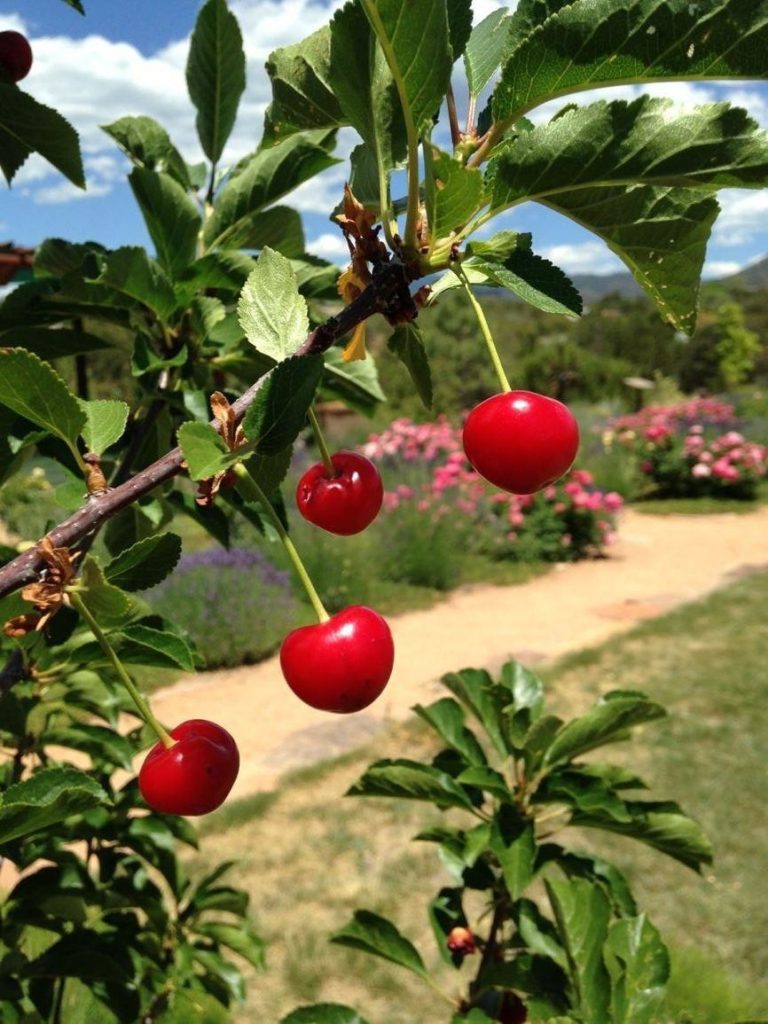
Prunus cerasus ‘Surefire’
Cherries were already a diet staple in the Iron Age (1200 B.C. to 600 B.C.) and have continued to grow in popularity since then. They originated in Asia Minor– the fertile areas between the Black and Caspian seas — apparently were spread to Europe by birds. The Greeks were the first to cultivate cherries and Romans expanded production. A cultivated cherry is recorded as having been brought to Rome by Lucius Licinius Lucullus from northeastern Anatolia in 72 BC.
In a story published by the Huffington Post, studies say that “cherry blossoms or sakura immigrated to Japan some time several thousand years ago and spread throughout the country before the prehistoric age.”
Tart cherries were brought by French colonists from Normandy to southern Canada and grown as far south as Michigan, which is the leading supplier in the United States today. Sweet cherries were brought to America by ship with early settlers in the 1600s. Three varieties are growing at SFBG’s Museum Hill – ‘White Gold’, ‘Black Gold’ and ‘Surefire’.
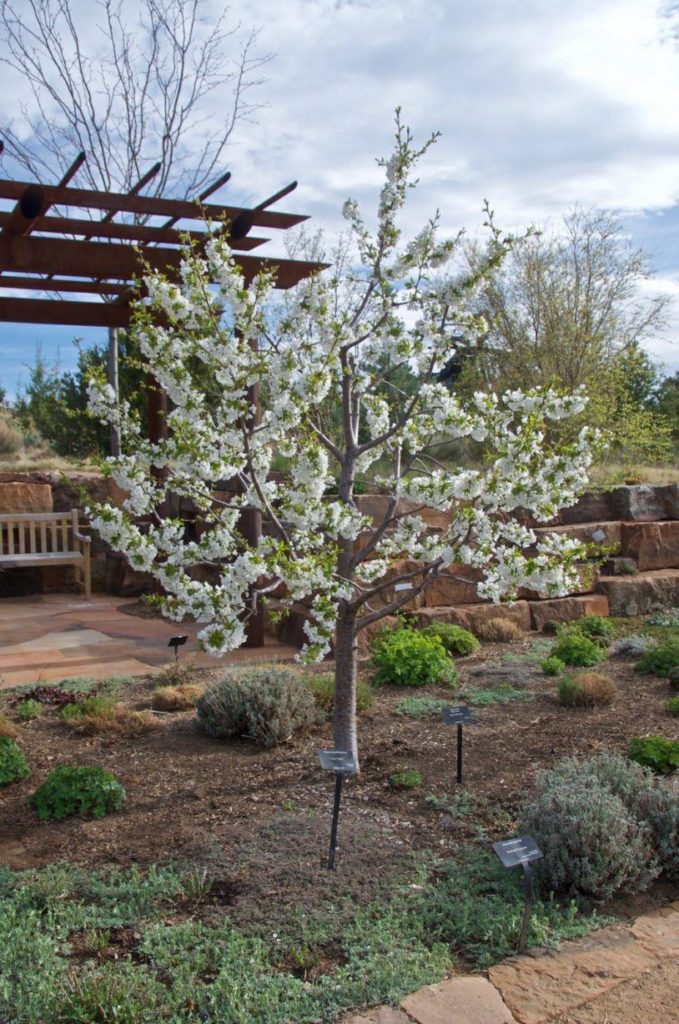
‘Black Gold’ cherry. Photo by Janice Tucker.
Prunus pumila is a native plant called sand cherry. This fast-growing shrub produced fruit immediately and many colonists relied upon it while waiting for their slow-growing trees to mature and produce fruit.
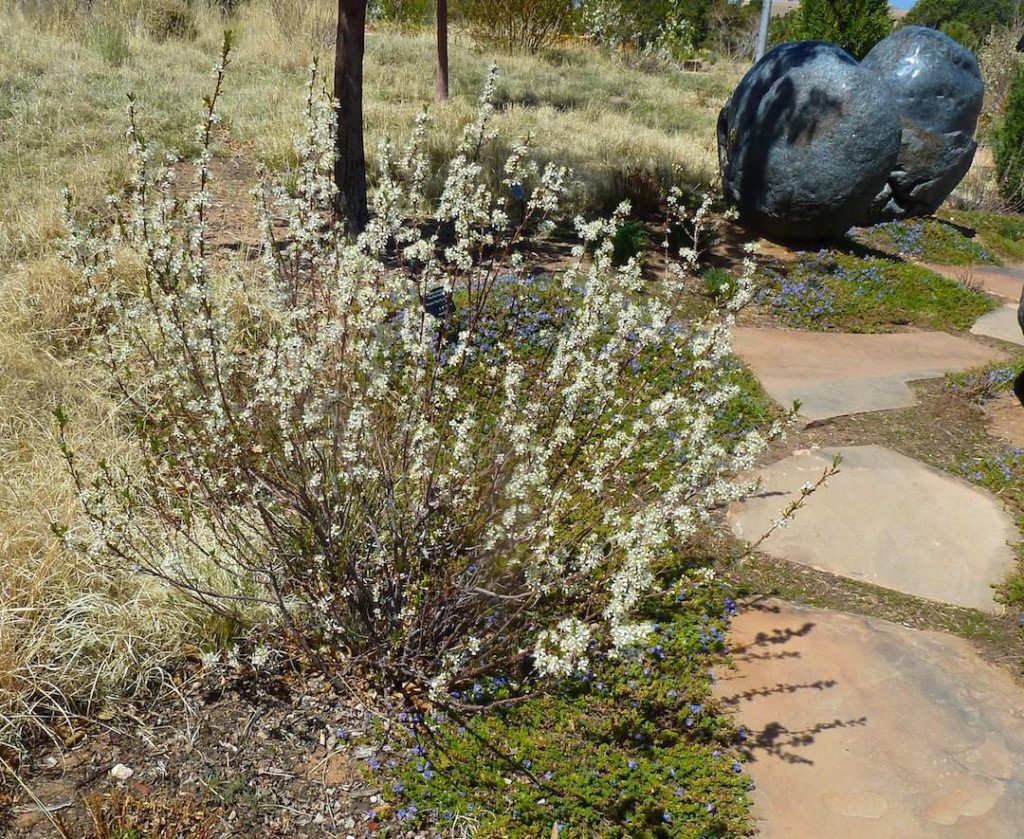
Prunus pumila var. besseyi, western sand cherry shrub. Photo by Janice Tucker.
With such a long history alongside human development the cherry has earned a place in mythology. The dark-red flesh of the fruit and its blood-colored juice are often associated with the human body — with the pit inside symbolizing new life or rebirth. In ancient Greek mythology, cherry trees contained the “elixir” that gave gods their immortality, while ancient Chinese lore said the magical Phoenix slept on a bed of cherry blossoms to attain everlasting life. In Buddhism, cherries represent fertility and femininity, since the mother of Buddha was said to be supported by a holy cherry tree as she gave birth.
Throughout Japan, the cherry, or ‘Sakura’ represents good fortune, new beginnings and revival. Folklore says that when the Sakura spirits release their gorgeous fragrance in springtime, their gift of beauty and elegance is to be truly celebrated.
More than 1,000 varieties of cherries grow in the wild, but only a handful are grown commercially for fruit production. Two main types of cherries are produced in the United States: sweet cherries and tart or “sour” cherries, according to the USDA Agricultural Marketing Service. Most sweet cherries — such as the heart-shaped ‘Bing’, the large, bright-red ‘Lambert’, and the gold-toned ‘Rainier’ — are grown in California, Washington, and Oregon. Tart cherries are mostly grown in Michigan, Utah and Washington.
Cherries need cold temps to produce fruit. Most cherries require at least 700 chill hours (hours below 45 degrees) in order to set fruit. If the trees do not get enough chill they will not produce fruit. There are varieties that require less chill. Sour cherries require a lower chill period of 500 hours. Note: with constant development of new cultivars, these qualifications may be changing; there are already some varieties that require less chill. Check with a local grower/specialist for new possibilities.
Sour cherries are self-pollinating. They do not require more than one tree to produce fruit. However sweet cherries generally require at least a couple of trees for proper cherry tree pollination.
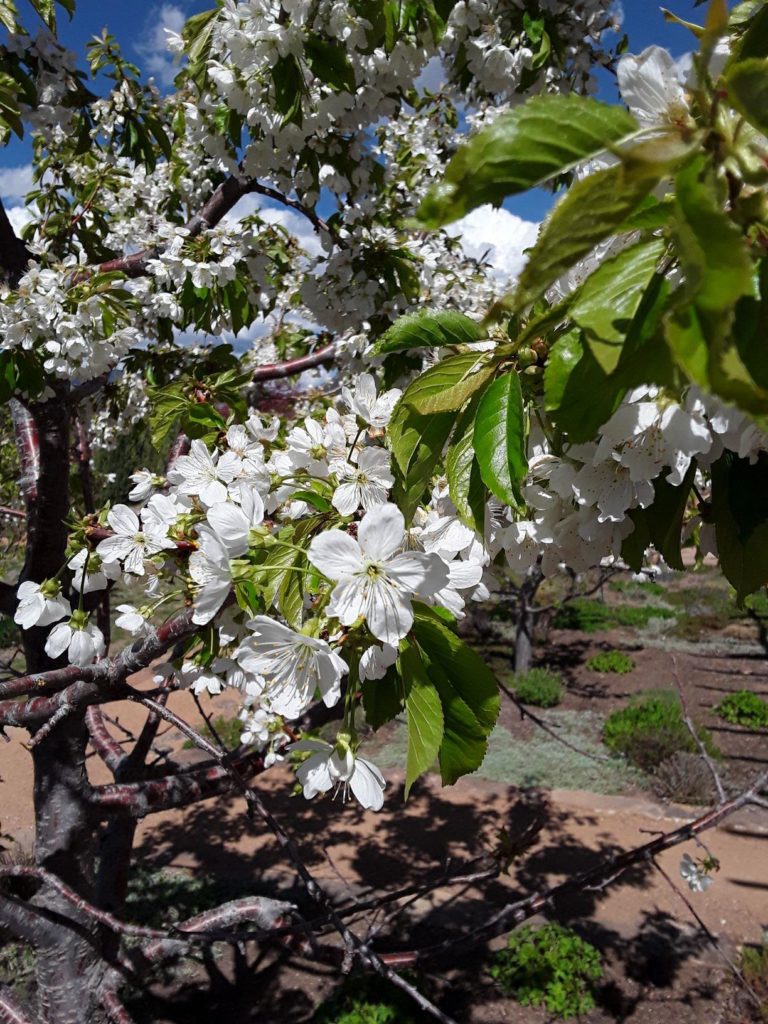
‘Black Gold’ cherry flowers.
Sweet cherries also require ample spacing to grow without crowding. They need to be planted 35-40 feet apart, although dwarf varieties need a mere 5-10 feet of breathing room. They require full sun and cannot tolerate wet feet.

Tracy Neal, horticulturalist.
Tracy Neal, local horticulturalist and tree specialist, helped select the cultivars of cherries for the Botanical Garden and provided background on their desirable traits. For the sweet cherries (‘Black Gold’ and ‘White Gold’), “Two of our goals in selecting trees for the orchard involved using self-fertile varieties as much as possible (so folks could plant just one if they wanted to and still get fruit) and using varieties that had the best chance possible of setting fruit in northern New Mexico (hence the late bloom). They are grafted onto a dwarfing rootstock that was developed in Germany called Gisela 5 (or G.5) which, like the varieties, is experimental in New Mexico. The old dwarfing rootstocks have a variety of problems (including not having much dwarfing effect) so G.5 was selected to overcome these, as well as inducing early fruit set. It has about a 50% dwarfing effect.” He adds that for the tart cherry (‘Surefire’), “It is later to bloom than Montmorency (the standard in tart cherries) and has a high sugar content, so can be eaten fresh as well as baked. It is also grafted onto G.5, so can easily be kept to 8-10′ at maturity.”
Be cautious with any stone fruit. The pits, leaves and twigs may contain a chemical that breaks down into a cyanide compound when ingested. Be certain to take care that everything but the fruit flesh is removed.
Every schoolchild can recite the story of George Washington and the cherry tree. George was only six years old when he received a hatchet for his birthday. Armed like a madman he descended into his father’s orchard and did serious damage to a favorite small cherry tree. When questioned he made his famous reply, “I cannot tell a lie,” and confessed. His father raised his children to always tell the truth no matter what, as he did. No one can say if this is fact or fiction. The story mysteriously circulated at a time when book sales were being promoted but it has a lasting place in cherry lore.
And those picturesque cherry blossoms that emerge in Washington, D.C., every spring? These trees number in the thousands and were a gift to D.C. from the city of Tokyo in 1912. They are incredibly showy but don’t produce edible fruit. According to the National Parks Service, the only cherries are tiny, black, and bitter, with a giant pit in the center.
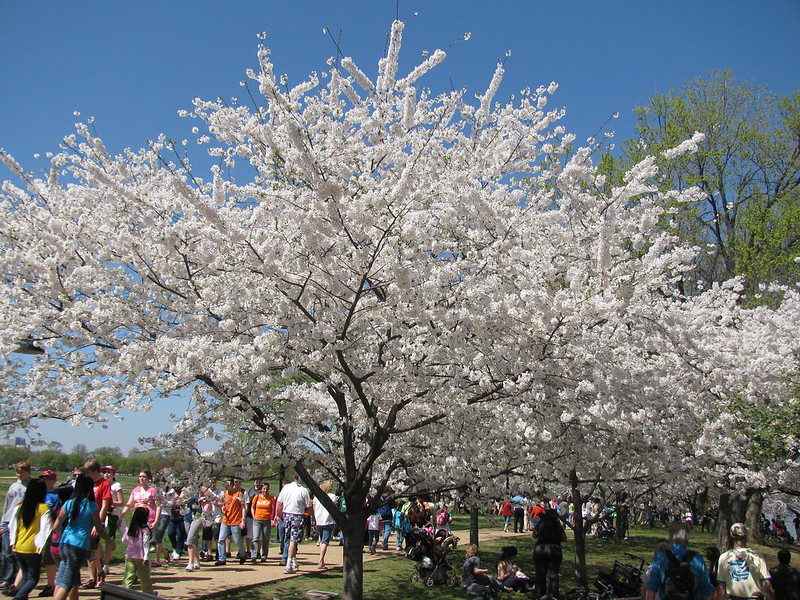
Washington DC cherry blossoms. Photo: Flickr, @dancingnomad3.
The cherry won its place in the gambling world quite by an accident of commerce. Cherries are king — especially on slot machines. According to “Professor Slots” Jon Friedl: When slot machines were first invented in the early 1900’s, a number of cities quickly banned them. “To circumvent these new laws on cash-paying slot machines,” Friedl says, “manufacturers began turning their gambling devices into chewing gum dispensers.” Numbers were replaced with fruit symbols, and three in a row won a piece of gum. Since cherry-flavored treats were most popular at the time, three cherries ultimately became the biggest — and most desired — win.
The maraschino cherry is pickled before being injected with gooey syrup. The ultimate of all cherries, the chocolate-covered was introduced by Cella’s Confections of New York (now Tootsie Roll) in 1929. It is a favorite in all parts of the world today. Cherries are here to stay. And contemporary data shows that the prehistoric population know what was good for them. Sweet cherries are found to reduce inflammation. Human trials point to the fact that cherries really do strengthen the immune system and help fight diseases like gout and arthritis. They are rich in nutrients as well.
References:
“Cherries”. Ag Marketing Resource Center. Sept 2021. Web. 1 Mar 2022. Retrieved from: https://www.agmrc.org/commodities-products/fruits/cherries
“Cherries”. Bay Laurel Nursery. Web. 1 Mar 2022. Retrieved from: https://baylaurelnursery.com/cherries.html
Mierzejewski, Kathee. “Cherry Tree Care – How To Grow Cherry Trees”. Gardening Know How. Web. 1 Mar 2022. Retrieved from: https://www.gardeningknowhow.com/edible/fruits/cherry/cherry-tree-care.htm
National Cherry Festival. Web. 1 Mar 2022. Retrieved from: https://www.cherryfestival.org/
“Prunus avium ‘White Gold’”. Garden Explorer. Santa Fe Botanical Garden. Web. 1 Mar 2022. Retrieved from: https://santafebotanicalgarden.gardenexplorer.org/taxon-582.aspx
“Prunus avium ‘Black Gold’”. Garden Explorer. Santa Fe Botanical Garden. Web. 1 Mar 2022. Retrieved from: https://santafebotanicalgarden.gardenexplorer.org/taxon-581.aspx
“Prunus cerasus ‘Surefire'”. Garden Explorer. Santa Fe Botanical Garden. Web. 1 Mar 2022. Retrieved from: https://santafebotanicalgarden.gardenexplorer.org/taxon-583.aspx
Wikipedia contributors. “Cherry.” Wikipedia, The Free Encyclopedia. Wikipedia, The Free Encyclopedia, 20 Apr. 2022. Web. 29 Apr. 2022. Retrieved from: https://en.wikipedia.org/wiki/Cherry


